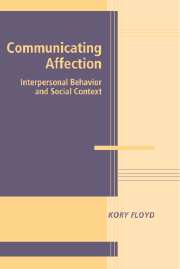Book contents
- Frontmatter
- Contents
- List of Tables
- List of Figures
- Foreword
- 1 AN INTRODUCTION TO AFFECTIONATE COMMUNICATION
- 2 THINKING ABOUT AFFECTION: THE THEORIES
- 3 ENCODING AFFECTIONATE MESSAGES
- 4 DECODING AND RESPONDING TO AFFECTIONATE EXPRESSIONS
- 5 BENEFITS OF EXPRESSING AND RECEIVING AFFECTION
- 6 RISKS ASSOCIATED WITH AFFECTIONATE COMMUNICATION
- 7 A NEW THEORETIC APPROACH
- 8 AFFECTIONATE COMMUNICATION IN HUMAN INTERACTION
- References
- Index
1 - AN INTRODUCTION TO AFFECTIONATE COMMUNICATION
Published online by Cambridge University Press: 02 December 2009
- Frontmatter
- Contents
- List of Tables
- List of Figures
- Foreword
- 1 AN INTRODUCTION TO AFFECTIONATE COMMUNICATION
- 2 THINKING ABOUT AFFECTION: THE THEORIES
- 3 ENCODING AFFECTIONATE MESSAGES
- 4 DECODING AND RESPONDING TO AFFECTIONATE EXPRESSIONS
- 5 BENEFITS OF EXPRESSING AND RECEIVING AFFECTION
- 6 RISKS ASSOCIATED WITH AFFECTIONATE COMMUNICATION
- 7 A NEW THEORETIC APPROACH
- 8 AFFECTIONATE COMMUNICATION IN HUMAN INTERACTION
- References
- Index
Summary
The choicest thing this world has for a man is affection.
– Josiah Gilbert HollandSocial scientists have long considered affection to be among the most fundamental of human needs (Rotter, Chance, & Phares, 1972; Schutz, 1958, 1966), and with good reason. The expression of affection is one of the primary communicative behaviors contributing to the formation (Owen, 1987), maintenance (Bell & Healey, 1992), and quality (Floyd & Morman, 1997, 1998, 2000a) of human relationships. It contributes to physical health (Komisaruk & Whipple, 1989), mental well-being (Downs & Javidi, 1990), and academic performance (Steward & Lupfer, 1987), and mitigates loneliness (Downs & Javidi, 1990) and depression (Oliver, Raftery, Reeb, & Delaney, 1993). Often, it is through one's expression of affection for another that a relationship is formed or transformed; indeed, relational partners often remember the first hug, the first kiss, or the first time the words “I love you” were spoken (see Owen, 1987). Affection is truly a central component of many social and personal relationships, from those that are casually close to those that are deeply intimate.
Despite the intuitive notion that affection is always a positive component of relational interaction, however, having affectionate feelings – and particularly communicating them – can in fact be fraught with risk. Consider the story of Jason and Lisa. They attend the same high school and have been dating each other for 3 months. In that time, they have enjoyed each other's company and confidences, and have both developed affectionate feelings for the other.
- Type
- Chapter
- Information
- Communicating AffectionInterpersonal Behavior and Social Context, pp. 1 - 8Publisher: Cambridge University PressPrint publication year: 2006



